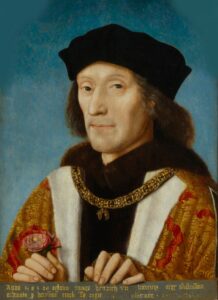 On this day in Tudor history, 24th January 1502, King Henry VII, the first Tudor monarch, ratified a peace treaty, the Treaty of Perpetual Peace, with King James IV of Scotland, at Richmond Palace in the presence of James’s representatives, Robert Blackadder, Archbishop of Glasgow, Patrick Hepburn, Earl of Bothwell, and Andrew Forman, who all signed it.
On this day in Tudor history, 24th January 1502, King Henry VII, the first Tudor monarch, ratified a peace treaty, the Treaty of Perpetual Peace, with King James IV of Scotland, at Richmond Palace in the presence of James’s representatives, Robert Blackadder, Archbishop of Glasgow, Patrick Hepburn, Earl of Bothwell, and Andrew Forman, who all signed it.
This treaty was a landmark agreement between England and Scotland aimed at ending two centuries of conflict between the two nations. It was a diplomatic triumph for both monarchs, King Henry VII of England and King James IV of Scotland, and it marked a rare moment of peaceful relations in what was often a turbulent and violent history.
It was called the Treaty of Perpetual Peace because it aimed to establish a lasting peace between the kingdoms, with the treaty stating that there would be “good, real and sincere, true, sound, and firm peace, friendship, league and confederation, to last all time coming”. An ambitious aim. Both kings promised not to make war against each other under threat of being excommunicated by the pope if they did.
On 10th December 1502, at the high altar of Glasgow Cathedral, James IV swore to the terms of the treaty, and it was sent on to the pope for his ratification by Henry VII in April 1503.
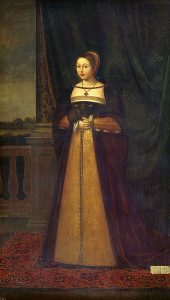 The treaty was win-win for both kings – for Henry, it meant peace on England’s northern border and a promise from Scotland that they wouldn’t support any pretenders to his throne, and for James it offered him stability and an alliance with his powerful neighbour.
The treaty was win-win for both kings – for Henry, it meant peace on England’s northern border and a promise from Scotland that they wouldn’t support any pretenders to his throne, and for James it offered him stability and an alliance with his powerful neighbour.
The treaty was cemented through the proposed marriage of Henry VII's eldest daughter, Margaret Tudor, and the Scottish king. Margaret and James were married by proxy on 25th January 1503 at Richmond Palace and on 27th June that year, Margaret set off for Scotland, arriving on 1st August. The couple’s official marriage took place at Edinburgh, in the chapel of Holyroodhouse on 8th August 1503. The occasion was marked by the Scottish court poet William Dunbar with “The Thrissle and the Rois”, or The Thistle and the Rose, the thistle being a symbol of the Scottish monarch and the rose referring to the Tudor rose. James and Margaret went on to have six children together, including the future James V of Scotland, but only he survived childhood.
Sadly, despite the two kings promising perpetual peace, peace lasted just 11 years, ending when James declared war on England in 1513 in support of his traditional and longstanding ally, France, who’d been attacked by England. Cardinal Christopher Bainbridge, by authority of the pope, excommunicated the Scottish king in the summer of 1513 but it didn’t prevent James from launching an invasion of England.The invasion didn’t go well. James’s troops met those of his brother-in-law, Henry VIII at the Battle of Flodden on 9th September 1513. It was a catastrophic defeat for Scotland. Henry VIII wasn’t present, being on campaign in France, so the English army, was led by Thomas Howard, Earl of Surrey. While the English lost around 1,500 men, the Scottish army lost 5,000 – 17,000, depending on which source you believe. Most of the Scottish aristocracy were killed and James IV was also killed. Margaret Tudor was left a widow and her seventeen-month-old son became King James V of Scotland, his mother acting as regent until her second marriage in August 1514.
Although the treaty itself failed to achieve its goal: perpetual peace, the marriage of Margaret Tudor and James IV had profound long-term consequences. Their great-grandson, King James VI of Scotland, inherited the English throne as James I of England in 1603, uniting the crowns of England and Scotland under one monarch. This event, known as the Union of the Crowns, was a direct result of the 1502 treaty and its marriage alliance.

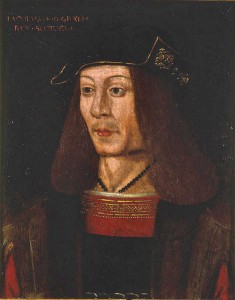
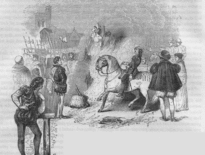
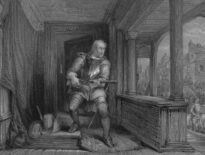
Great article, thank you.
I find James IV very interesting, and Henry VIII was pushing his luck with the treaty almost from the beginning of his reign. Even though it was obvious there would be conflict between them within months, James sent condolences to Henry on the death at sea of Edward Howard, Surrey’s son drowned while attacking the French,
asking that his words be received in the spirit in which they were sent, ‘We are truly sorry … through acquaintance we had of his father, that noble knight who conveyed our dearest companion the Queen to us.’